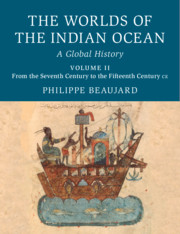Book contents
- The Worlds of the Indian Ocean
- The Worlds of the Indian Ocean
- The Worlds of the Indian Ocean
- Copyright page
- Dedication
- Contents
- Maps and Charts (in Color Plates)
- Illustrations (in Color Plates)
- Figures
- Tables
- Abbreviations
- Part I The Indian Ocean between Tang China and the Muslim Empire (Seventh–Tenth Century)
- Introduction
- Chapter 1 Tang China and the Rise of the Silk Roads
- Chapter 2 Islam: The Conquest of Lands and Oceans
- Chapter 3 India: A Core with Four Centers
- Chapter 4 Southeast Asia: The Rise of the Srīwijayan Thalassocracy and the Javanese Kingdoms
- Chapter 5 East Africa: Dawn of the Swahili Culture
- Chapter 6 Madagascar (Seventh–Eleventh Century): Early Cultural Hybridization
- Part II Globalization during the Song and Mongol Periods (Tenth–Fourteenth Century), and the Downturn of the Fourteenth Century
- Part III From the Globalization of the Afro-Eurasian Area to the Dawn of European Expansion (Fifteenth and Early Sixteenth Centuries)
- Bibliography
- Index of Geographical Names
- Name Index
- Subject Index
Chapter 4 - Southeast Asia: The Rise of the Srīwijayan Thalassocracy and the Javanese Kingdoms
from Part I - The Indian Ocean between Tang China and the Muslim Empire (Seventh–Tenth Century)
Published online by Cambridge University Press: 14 October 2019
- The Worlds of the Indian Ocean
- The Worlds of the Indian Ocean
- The Worlds of the Indian Ocean
- Copyright page
- Dedication
- Contents
- Maps and Charts (in Color Plates)
- Illustrations (in Color Plates)
- Figures
- Tables
- Abbreviations
- Part I The Indian Ocean between Tang China and the Muslim Empire (Seventh–Tenth Century)
- Introduction
- Chapter 1 Tang China and the Rise of the Silk Roads
- Chapter 2 Islam: The Conquest of Lands and Oceans
- Chapter 3 India: A Core with Four Centers
- Chapter 4 Southeast Asia: The Rise of the Srīwijayan Thalassocracy and the Javanese Kingdoms
- Chapter 5 East Africa: Dawn of the Swahili Culture
- Chapter 6 Madagascar (Seventh–Eleventh Century): Early Cultural Hybridization
- Part II Globalization during the Song and Mongol Periods (Tenth–Fourteenth Century), and the Downturn of the Fourteenth Century
- Part III From the Globalization of the Afro-Eurasian Area to the Dawn of European Expansion (Fifteenth and Early Sixteenth Centuries)
- Bibliography
- Index of Geographical Names
- Name Index
- Subject Index
Summary
The break-up of Funan during the seventh century and the turmoil affecting China during the eighth century left the field clear for political entities located in southeastern Sumatra, where Srīwijaya took the upper hand over Melayu (Jambi) between 671 and 685. As late as 644–645, Melayu dispatched an embassy to China. During his second visit to the east coast of Sumatra, the Chinese pilgrim Yijing noted that “Moluoyou is now Shilifoshi [Srīwijaya].” The 683 inscription of Kedukan Bukit (Palembang, capital of the state) mentions the departure of the army of Srīwijaya, probably toward Melayu (Mahdi 2008: 118). In addition, the king of Srīwijaya may have launched a naval expedition toward Java (Kulke 2001: 302), a testimony to politico-economic and perhaps religious rivalry (western Java being Vishnuite and Srīwijaya Buddhist).
- Type
- Chapter
- Information
- The Worlds of the Indian OceanA Global History, pp. 88 - 105Publisher: Cambridge University PressPrint publication year: 2019

